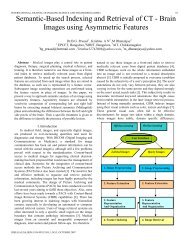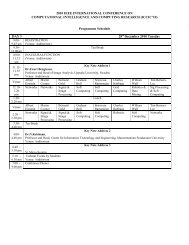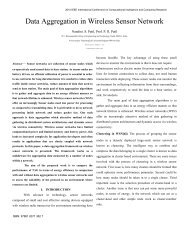Design of Intelligent Self-Tuning Temperature Controller - Itfrindia.org
Design of Intelligent Self-Tuning Temperature Controller - Itfrindia.org
Design of Intelligent Self-Tuning Temperature Controller - Itfrindia.org
You also want an ePaper? Increase the reach of your titles
YUMPU automatically turns print PDFs into web optimized ePapers that Google loves.
INTERNATIONAL JOURNAL OF IMAGING SCIENCE AND ENGINEERING (IJISE) 121<br />
<strong>Design</strong> <strong>of</strong> <strong>Intelligent</strong> <strong>Self</strong>-<strong>Tuning</strong> <strong>Temperature</strong><br />
<strong>Controller</strong> for Water Bath Process<br />
1 Melba Mary.P, 2 Marimuthu N.S 3 Albert Singh. N.<br />
1 NCE, Anna University, TamilNadu<br />
2 GCE, 3 College <strong>of</strong> Engineering, University <strong>of</strong> Kerala.<br />
1 melbance_2k4@yahoo.co.in , 2 drnsmphd@yahoo.co.in, 3 mailalbertsingh@yahoo.co.in<br />
Abstract - This paper proposes a novel approach based on selftuning<br />
fuzzy logic control and genetic algorithm optimized fuzzy<br />
logic controller, for the design <strong>of</strong> a temperature control process,<br />
capable <strong>of</strong> providing optimal performance over the entire operating<br />
range <strong>of</strong> the process. The proposed control system combines the<br />
advantages <strong>of</strong> Genetic Algorithm and Fuzzy Logic Control schemes.<br />
In order to evaluate the performance <strong>of</strong> the proposed control system<br />
methods, results from simulation <strong>of</strong> the process are presented.<br />
Key Words: Genetic Algorithm (GA), Fuzzy Logic Control<br />
(FLC)<br />
I. INTRODUCTION<br />
FUZZY logic control systems, which have the capability<br />
<strong>of</strong> transforming linguistic information and expert knowledge<br />
into control signals [1], [2], are currently being used in a wide<br />
variety <strong>of</strong> engineering applications. The simplicity <strong>of</strong><br />
designing these fuzzy logic systems has been the main<br />
advantage <strong>of</strong> their successful implementation over traditional<br />
approaches such as optimal and adaptive control techniques.<br />
Despite the advantages <strong>of</strong> the conventional Fuzzy Logic<br />
<strong>Controller</strong> (FLC) over traditional approaches, there remain a<br />
number <strong>of</strong> drawbacks in the design stages. Even though rules<br />
can be developed for many control applications, they need to<br />
be set up through expert observation <strong>of</strong> the process. The<br />
complexity in developing these rules increases with the<br />
complexity <strong>of</strong> the process. FLC’s also consist <strong>of</strong> a number <strong>of</strong><br />
parameters that are needed to be selected and configured in<br />
prior, such as selection <strong>of</strong> scaling factors, configuration <strong>of</strong> the<br />
center and width <strong>of</strong> the membership functions, and selection<br />
<strong>of</strong> the appropriate fuzzy control rules.<br />
Due to their learning capability, artificial neural networks<br />
are being sought in the development <strong>of</strong> neuro-fuzzy<br />
controllers or adaptive FLC’s. Berenji [3] developed a FLC<br />
that is capable <strong>of</strong> learning as well as tuning <strong>of</strong> its parameters<br />
by using neural length strings. In another development,<br />
Shimojima et al. [4] used GA to tune a type <strong>of</strong> Radial Basis<br />
Function (RBF) based fuzzy model, with only three fuzzy<br />
memberships for each fuzzy variable. Jang [9] developed a<br />
self-learning FLC based on a neural network trained by<br />
temporal back-propagation. Lee et al. [5] proposed a self<strong>org</strong>anizing<br />
fuzzified basis function based on the competitive<br />
learning scheme. Recently, Ling [6] proposes a model-based<br />
fuzzy gain scheduling technique and applies it to the real-time<br />
control <strong>of</strong> laboratory-scale water–gas shift reactor. However,<br />
GA’s are currently being investigated for the development <strong>of</strong><br />
adaptive or self-tuning fuzzy logic control systems. This paper<br />
IJISE,GA,USA,ISSN:1934-9955,VOL.1,NO.4, OCTOBER 2007<br />
presents a self-tuning fuzzy and also a fuzzy logic controller<br />
where its gain parameters can be tuned simultaneously by GA.<br />
II. PROBLEM FORMULATION<br />
The continuous-time temperature control system [7] is<br />
described as<br />
dy( t)<br />
f ( t)<br />
Yo − y(<br />
t)<br />
= +<br />
…..(1)<br />
dt C RC<br />
where t denotes time, y(t) is the output temperature in °C, f<br />
(t) is the heat flowing inward the system, Y o , is the room<br />
temperature (constant, for simplicity), C denotes the system<br />
thermal capacity, and R is the thermal resistance between the<br />
system borders and surroundings. Assuming that R and C are<br />
essentially constant, obtaining the pulse transfer function for<br />
the system in (1) by the step response criterion results in the<br />
discrete-time system<br />
y( k + 1) = a(<br />
Ts ) y(<br />
k)<br />
+ b(<br />
Ts)<br />
u(<br />
k)<br />
……(2)<br />
where k is the discrete-time index, u(k) and y( k) denote the<br />
system input and output, respectively, and T s is the sampling<br />
period. Denoting by α and β some constant values depending<br />
on R and C, the remaining parameters can be expressed by<br />
−α ( Ts)<br />
a(<br />
Ts)<br />
= e and<br />
β<br />
− α ( Ts )<br />
b ( T s ) = (1 − e ) ……(3)<br />
α<br />
The system described in (1)-(3) was modified to include a<br />
saturating non-linearity so that the output temperature cannot<br />
exceed some limitation.<br />
The simulated control plant is described by<br />
….(4)<br />
where a(T s ) and b(T s ) are given by (3). The parameters for<br />
simulation are α = 1.00151E-4, β = 8.67973E-3, γ =40.0, and<br />
Yo = 25.0 °C, which were obtained from a real water bath<br />
plant. The plant input u(k) was limited between 0 and 5, and it<br />
is also assumed that the sampling period is limited by<br />
T s<br />
≥ 10s<br />
…….(5)<br />
With the chosen parameters, the simulated system is<br />
equivalent to a SISO temperature control system <strong>of</strong> a water
P.MELBA MARY, N.S.MARIMUTHU et al.,: DESIGN OF INTELLIGENT SELF-TUNING TEMPERATURE CONTROLLER FOR WATER BATH PROCESS 122<br />
bath that exhibits linear behavior up to about 70°C and then<br />
becomes nonlinear and saturates at about 80°C. The Schematic<br />
Diagram <strong>of</strong> the water bath process is shown in Fig.1.<br />
with neighboring MF’s as shown in Fig. 3. This is the most<br />
natural and unbiased choice for MF’s.<br />
Computer<br />
1<br />
NB NM NS ZE PS PM PB<br />
D/A<br />
A/D<br />
PWM<br />
SM<br />
-1 -0.5 0 0.5 1<br />
~<br />
Fig.1 Water bath control system<br />
III. DESIGN PROCEDURE<br />
A. MAIN IDEA OF THE FLC<br />
In this section, we present the main ideas underlying<br />
the FLC. To highlight the issues involved, Fig. 2 shows the<br />
basic configuration <strong>of</strong> an FLC, which comprises four principal<br />
components: a fuzzification interface, a knowledge base,<br />
decision making logic, and a defuzzification interface.<br />
Fuzzification<br />
Interface<br />
Fuzzy<br />
Process output<br />
& state<br />
Knowledge Base<br />
Decision<br />
Making<br />
Logic<br />
Controlled<br />
System [Process]<br />
Heater<br />
Water bath<br />
Defuzzification<br />
Interface<br />
Fuzzy<br />
Fig.2 Fuzzy Logic <strong>Controller</strong><br />
Stirrer<br />
Sensor<br />
Actual control<br />
Non fuzzy<br />
NB: Negative Big<br />
NM: Negative Medium<br />
NS: Negative Small<br />
ZE: Zero<br />
PS: Positive Small<br />
PM: Positive Medium<br />
PB: Positive Big<br />
Fig.3 Triangular Membership function<br />
The fuzzy control rules have the form:<br />
R 1 : if x is A 1 and y is BB1 then z is C 1<br />
R 2 : if x is A 2 and y is BB2 then z is C 2<br />
…………………………………….<br />
R n : if x is A n and y is BBn then z is C n<br />
where x, y and z are linguistic variables representing<br />
two process state variables and one control variable; A i , B i<br />
and C i are linguistic values <strong>of</strong> the linguistic variables x , y and<br />
z in the universes <strong>of</strong> discourse U , V, and W , respectively,<br />
with i = 1,2; . , n; and an implicit sentence connective also<br />
links the rules into a rule set or, equivalently a rule base. For<br />
converting the inferred fuzzy control action to real value,<br />
centroid method is used.<br />
B. <strong>Self</strong>-<strong>Tuning</strong> Fuzzy For Input And Output Gain <strong>Tuning</strong><br />
To make the system adaptive the input and output gain <strong>of</strong><br />
these controllers are adjusted on-line according to the current<br />
states <strong>of</strong> the controlled processes, i.e gain scheduling using<br />
fuzzy logic thereby making them self-tuning FLC’s [8]. This<br />
logic is depicted as shown in Fig.4. in which G e and G ce are<br />
proportional and derivative gains respectively in the input side<br />
<strong>of</strong> the FLC and G u is the output scaling gain. The adaptation<br />
rules for the input gain G e is shown in Table I, whereas for G ce<br />
the rules are opposite to that <strong>of</strong> G e .<br />
A1. Membership Functions<br />
All Membership Functions (MF’s) for 1) controller<br />
inputs, i.e., error and change <strong>of</strong> error and 2) incremental<br />
change in controller output for PI-type FLC or controller<br />
output for PD-type FLC, are defined on the common interval<br />
[1, 1]; whereas the MF’s for the gain updating factor is<br />
defined on [0, 1]. We use symmetric triangles (except the two<br />
MF’s at the extreme ends) with equal base and 50% overlap<br />
e<br />
d/dt<br />
Fuzzy Gain Scheduler<br />
G e<br />
G ce<br />
Fuzzy<br />
Logic<br />
<strong>Controller</strong><br />
Fig.4 Structure <strong>of</strong> the self tuning FLC<br />
G u<br />
IJISE,GA,USA,ISSN:1934-9955,VOL.1,NO.4, OCTOBER 2007
INTERNATIONAL JOURNAL OF IMAGING SCIENCE AND ENGINEERING (IJISE) 123<br />
ΔE G e<br />
TABLE I<br />
Inference Rules <strong>of</strong> the input gain G e<br />
E NB NM NS Z PS PM PB<br />
NB PB PB PB PB PM Z Z<br />
NM PB PB PB PB PM Z Z<br />
NS PM PM PM PS Z NS NS<br />
Z PM PM PS Z NS NM NM<br />
PS PS PS Z NS NM NM NM<br />
PM Z Z NM NB NB NB NB<br />
PB Z Z NM NB NB NB NB<br />
C. Genetic Algorithm for Input And Output Gain <strong>Tuning</strong><br />
Though GA can be used as a flexible method for input<br />
space partitioning, it has the major disadvantage <strong>of</strong> consuming<br />
much time, we have proposed here to use GA to tuning <strong>of</strong><br />
input output gains [9] so that the convergence will be quicker<br />
and better result compared the plant without GA. Gain<br />
scheduling using genetic algorithms is shown in Fig.5,wherein<br />
G e and G d represents proportional and derivative gains<br />
respectively in the input side <strong>of</strong> FLC and G u is the output<br />
scaling gain.<br />
e<br />
G e<br />
GA Gain Scheduler<br />
Fuzzy Logic<br />
<strong>Controller</strong><br />
G u<br />
probabilistic decision to guide the search, where the<br />
population improves toward near optimal points from<br />
generation to generation. GA’s consist <strong>of</strong> three basic<br />
operations: reproduction, crossover, and mutation.<br />
Reproduction is the process where members <strong>of</strong> the population<br />
reproduced according to the relative fitness <strong>of</strong> the individuals,<br />
where the chromosomes with higher fitness have higher<br />
probabilities <strong>of</strong> having more copies in the coming generation.<br />
There are a number <strong>of</strong> selection schemes available for<br />
reproduction, such as “roulette wheel,” “tournament scheme,”<br />
“ranking scheme,” etc. [10]. Crossover in GA occurs when the<br />
selected chromosomes exchange partially their information <strong>of</strong><br />
the genes, i.e., part <strong>of</strong> the string is interchanged within two<br />
selected candidates. Mutation is the occasionally alteration <strong>of</strong><br />
states at a particular string position. Mutation is essentially<br />
needed in some cases where reproduction and crossover alone<br />
are unable to <strong>of</strong>fer the global optimal solution. It serves as an<br />
insurance policy, which would recover the loss <strong>of</strong> a particular<br />
piece <strong>of</strong> information.<br />
IV. SIMULATION STUDY<br />
Using the mathematical model <strong>of</strong> the real water bath plant<br />
our proposed approaches has been tested. From the initial<br />
condition y(0) = Yo = 25°C, the target is to follow a control<br />
reference set to 35.0°C for 0
P.MELBA MARY, N.S.MARIMUTHU et al.,: DESIGN OF INTELLIGENT SELF-TUNING TEMPERATURE CONTROLLER FOR WATER BATH PROCESS 124<br />
Temp in deg.<br />
90<br />
80<br />
70<br />
60<br />
50<br />
40<br />
30<br />
20<br />
10<br />
actual<br />
reference<br />
control signal<br />
0<br />
0 20 40 60 80 100 120 140 160 180<br />
k<br />
Fig.7 Performance <strong>of</strong> the simulated system<br />
using self-tuning fuzzy logic controller<br />
Temp in deg.<br />
90<br />
80<br />
70<br />
60<br />
50<br />
40<br />
30<br />
20<br />
10<br />
actual<br />
reference<br />
control signal<br />
0<br />
0 20 40 60 80 100 120 140 160 180<br />
k<br />
Fig8 Performance <strong>of</strong> the simulated system using<br />
Genetic Algorithm tuned fuzzy logic controller<br />
The comparison <strong>of</strong> the proposed approaches is made by<br />
calculating the performance index absolute error over the<br />
entire simulation period and is shown in Table II.<br />
Table .II<br />
Methodology Absolute error<br />
Conventional Fuzzy 306.22<br />
<strong>Self</strong>-<strong>Tuning</strong> Fuzzy 303.5<br />
GA-tuned Fuzzy 302.1<br />
V. CONCLUSION<br />
This paper has presented a comparison performance <strong>of</strong> a<br />
conventional fuzzy, a self tuned fuzzy and a GA tuned fuzzy<br />
controller where all <strong>of</strong> its gain parameters can be<br />
simultaneously tuned for a water bath temperature process. By<br />
appropriate coding <strong>of</strong> the FLC parameters, it can achieve selftuning<br />
properties from an initial random state. By employing<br />
dynamic crossover and mutation probability rates, the tuning<br />
process by GA was further improved. In the simulation study,<br />
the control performance has been compared to a GA tuned<br />
FLC controller, a self tuned FLC and also the conventional<br />
FLC. It was observed that the applied GA tuned FLC<br />
performed relatively better than the other two controllers.<br />
Compared to the conventional FLC, the self tuning FLC can<br />
somewhat eliminate laborious design steps such as manual<br />
tuning <strong>of</strong> the scaling factors and membership functions, and<br />
also selection <strong>of</strong> the fuzzy rules. Though it can be argued that<br />
in the proposed FLC, before GA can be used to optimize its<br />
parameters, initial encoding and settings are required, such<br />
procedures are somewhat relatively simpler and more<br />
systematic than heuristic. In addition, this paper also shows<br />
the flexibility <strong>of</strong> the proposed methodology in applying the<br />
different types <strong>of</strong> performance indices (i.e. absolute error) for<br />
various types <strong>of</strong> control systems. The performance indices<br />
used was rather straightforward and simple, yet resulted in<br />
satisfactory system response.<br />
VI. ACKNOWLEDGEMENT<br />
The authors would like to thank the Management and<br />
Principal <strong>of</strong> NATIONAL COLLEGE OF ENGINEERING for<br />
their constant encouragement and give permission to make use<br />
<strong>of</strong> the facilities provided in the Electrical and Electronics<br />
Engineering laboratory which is well established with the<br />
installation <strong>of</strong> MATLAB-7 s<strong>of</strong>tware with necessary tool boxes<br />
for doing simulation <strong>of</strong> our water bath process.<br />
VII. REFERENCES<br />
[1]. C. C. Lee, “Fuzzy logic in control systems: Fuzzy logic controller-Part I,”<br />
IEEE Trans. Syst., Man, Cybern., vol. 20, pp.404-418, 1990.<br />
[2]. C .C .Lee -, “Fuzzy logic in control systems: Fuzzy logic controller-Part<br />
II,” IEEE Trans. Syst., Man, Cybern., vol. 20, pp. 419-435, 1990.<br />
[3]. H. R. Berenji, “Learning and tuning fuzzy logic controllers through<br />
reinforcements,” IEEE Trans. Neural Networks, vol. 3, pp.724–740, Sept.<br />
1992.<br />
[4]. K. Shimojima, T. Fukuda, and Y. Hasegawa, “<strong>Self</strong>-tuning fuzzy modeling<br />
with adaptive membership function, rules, and hierarchical structure<br />
based on genetic algorithm,” Fuzzy Sets Syst., vol. 71, pp. 295–309, 1995.<br />
[5]. T. H. Lee, J. H. Nie, and W. K. Tan, “A self-<strong>org</strong>anizing fuzzified basis<br />
function network control system applicable to nonlinear servo<br />
mechanisms,” Mechatronics, vol. 5, no. 6, pp. 695–713, 1995.<br />
[6]. H. Oshima, S. Yasunobu, and S. Sekino, “Automatic train operation<br />
system based on predictive fuzzy control,” in Int. Workshop Artificial<br />
Intelligence Industrial Applications 1988, pp. 485–489.<br />
[7]. Julio Tanomaru, “Process Control by On-Line Trained Neural<br />
<strong>Controller</strong>s,” IEEE Trans. Industrial Electronics, vol. 39, pp. 511–521,<br />
Dec. 1992.<br />
[8]. Rajani K. Mudi and Nikhil R. Pal, “A Robust <strong>Self</strong>-<strong>Tuning</strong> Scheme for PIand<br />
PD-Type Fuzzy <strong>Controller</strong>s, IEEE Trans. Fuzzy Systems, vol. 7,<br />
No.1 pp.2–16, Feb.1999.<br />
[9]. Teo Lian Seng, Marzuki Bin Khalid, “<strong>Tuning</strong> <strong>of</strong> a Neuro-Fuzzy<br />
<strong>Controller</strong> by Genetic Algorithm, IEEE Transactions On Systems, Man,<br />
And Cybernetics—Part B: Cybernetics, Vol. 29, No. 2, April 1999.<br />
[10]. J. Kim, Y. Moon, and B. P. Zeigler, “<strong>Design</strong>ing fuzzy net<br />
controllers using genetic algorithms,” IEEE Contr. Syst., vol. 15, No. 3,<br />
pp. 66–72.<br />
IJISE,GA,USA,ISSN:1934-9955,VOL.1,NO.4, OCTOBER 2007


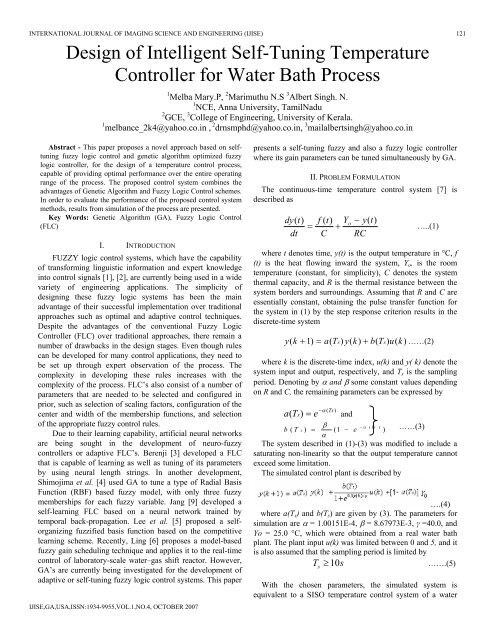
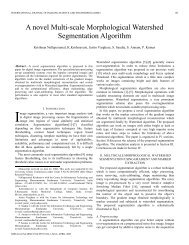
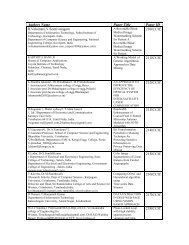

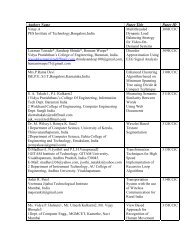
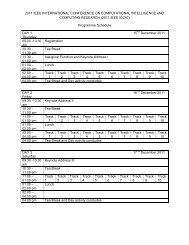

![Accepted Paper List I[Click to Download]](https://img.yumpu.com/34797283/1/190x245/accepted-paper-list-iclick-to-download.jpg?quality=85)
